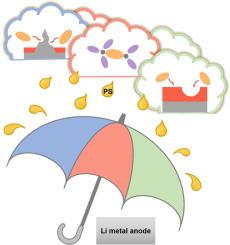Materials Today ( IF 21.1 ) Pub Date : 2021-04-18 , DOI: 10.1016/j.mattod.2020.10.021 Li-Peng Hou , Xue-Qiang Zhang , Bo-Quan Li , Qiang Zhang

|
The lithium–sulfur (Li–S) battery has raised great expectations as a next-generation high-energy-density energy storage system. The multielectron dissolution–precipitation redox conversion of S affords a great contribution to its high specific energy. Spontaneously, the highly reactive Li metal anode always confronts soluble Li polysulfides (LiPSs) in a working Li–S battery, and parasitically side reactions occur inevitably. The challenges of the Li metal anode induced by soluble LiPSs emerge as roadblocks for practical Li–S batteries with the development of the S cathode from its infancy into growth stage. Therefore, the fundamental understanding of Li anode in the electrolyte with LiPSs and the targeted protection strategies are urgently required. In this review, the challenges of the Li metal anode in the presence of LiPSs are systematically analyzed. Then, the preliminary advances in Li metal anode protection to deal with LiPSs are summarized. Finally, an insightful outlook is put forward through both a fundamental understanding and a practical exploration of the Li metal anode to promote the development of practical Li–S batteries.
中文翻译:

可溶性多硫化物锂金属负极在实际锂硫电池中的挑战和前景
锂硫(Li-S)电池作为下一代高能量密度储能系统备受期待。S 的多电子溶解-沉淀氧化还原转化对其高比能做出了巨大贡献。自发地,在工作的 Li-S 电池中,高反应性锂金属负极总是面对可溶性锂多硫化物 (LiPSs),并且不可避免地会发生寄生副反应。随着 S 正极从初期发展到成长阶段,由可溶性 LiPS 诱导的锂金属负极的挑战成为实用 Li-S 电池的障碍。因此,迫切需要对具有 LiPS 的电解质中的锂负极和有针对性的保护策略有基本的了解。在这次审查中,系统分析了存在 LiPS 时锂金属负极的挑战。然后,总结了锂金属负极保护以处理 LiPS 的初步进展。最后,通过对锂金属负极的基本理解和实践探索,提出了有见地的展望,以促进实用锂硫电池的发展。










































 京公网安备 11010802027423号
京公网安备 11010802027423号